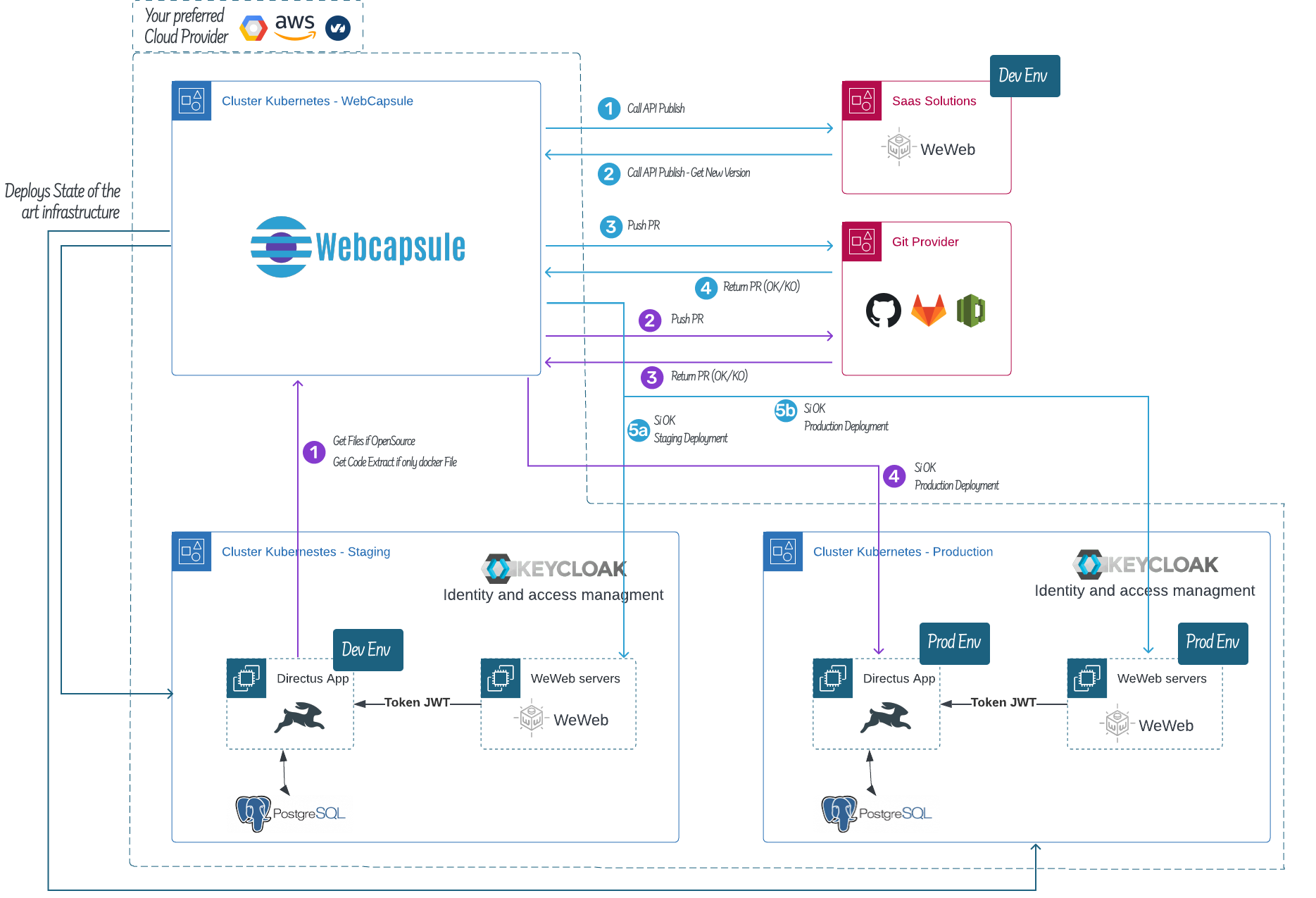Continuous Integration - Continuous Deployment
CICD WebCapsule

This diagram visualizes CI/CD flows for visual development architectures blending Open-Source tools and proprietary tools.
Versioning
When managing a complex and large-scale application, it's crucial to establish a version control system to track changes and resolve conflicts. Git is the most commonly used tool for this purpose, allowing developers to merge changes made by multiple team members into a single codebase.
However, Git isn't always the best option for managing changes to assets other than code, such as databases or content management systems (CMS).
Our system can contribute to ensuring a consistent development flow across the entire stack, facilitating collaboration with team members and maintaining a high level of quality in your application.
Versions
Every change made to your tools can be recorded as a new version, enabling you to revert to a previous state if necessary. This approach is particularly useful when working with multiple team members or making frequent updates to the application.
Branches (beta)
Branching is a common practice in software development, involving creating a distinct copy of the codebase to isolate changes from the main branch. This allows developers to work on new features or bug fixes without disrupting the stability of the main codebase. Once changes have been tested and reviewed, they can be merged into the main branch. Our system allows for creating similar branches and merging changes made to assets other than code, such as databases or content management systems (CMS).
This feature is made possible through the implementation of rds blue-green deployment
Environments
Our system offers at least two environments: staging and production.
The staging environment is where you can preview new versions of your application before deploying them to production. This environment is designed to be as close as possible to the production environment, allowing you to test your application under realistic conditions without affecting your users.
The production environment is where your application is live and accessible to users. It's optimized for performance, scalability, and reliability, designed to handle high levels of traffic and workload.
Using separate environments for testing and production has several advantages. Firstly, it allows you to test new versions of your application in a safe and controlled environment without affecting your users or risking downtime. Secondly, it helps you identify and fix issues or bugs before they affect your users. Lastly, it enables you to preview new features or changes in your application before deploying them to production, giving you better control over the user experience.
Overall, using distinct test and production environments ensures the quality and reliability of your application while reducing the risk of downtime or disruptions for users.
Deployments
Trigger
Our system offers two ways to deploy a new version of your application. The first is manual deployment, which can be triggered with a simple click. The second is automated deployment, which can be automatically triggered when a new version is submitted. Both methods are designed to make the deployment process as simple and efficient as possible.
Strategy
Two deployment strategies are available: continuous deployment and Blue-Green. Both strategies are designed to minimize downtime.
Continuous Deployment Continuous deployment involves deploying updates to a subset of servers at a time while keeping the previous version on the rest of the servers. This means that if an issue arises with the update, it will only affect a small portion of users. Once the update is validated, it is deployed to all servers. This process is repeated until all servers are using the new version.
Blue-Green Deployment Blue-Green deployment involves deploying updates in a completely separate environment called "Blue" while keeping the current environment, called "Green," operational. Once the proper functioning of the Blue environment is confirmed, traffic is gradually redirected from the Green environment to the Blue environment until all traffic is directed to the new environment. This method allows for an instant rollback in case of issues with the new environment.
These two strategies ensure minimal downtime during deployment.
Automatic Updates (beta)
Our system has processes in place to manage minor and major updates. For minor updates, our team ensures that updates are compatible with your existing tools and packages and thoroughly tests them before implementing them. This ensures that your applications continue to run smoothly.
For major updates, we prioritize transparent communication. We send an email notification to all our clients, explaining the changes and providing a tutorial on how to update your tools while ensuring compatibility. We understand that major updates can be daunting, but we are here to guide you every step of the way.
By keeping your tools and packages up to date, you have access to the latest features while ensuring the stability and smooth operation of your application.
Rollback
Our system allows you to easily revert to a previous version of your application if necessary. Every change made to your tools can be recorded as a new version, giving you the opportunity to return to a previous state when needed. This approach proves particularly useful when working with multiple team members or making frequent updates to the application. 🔄🛠️🚀✨